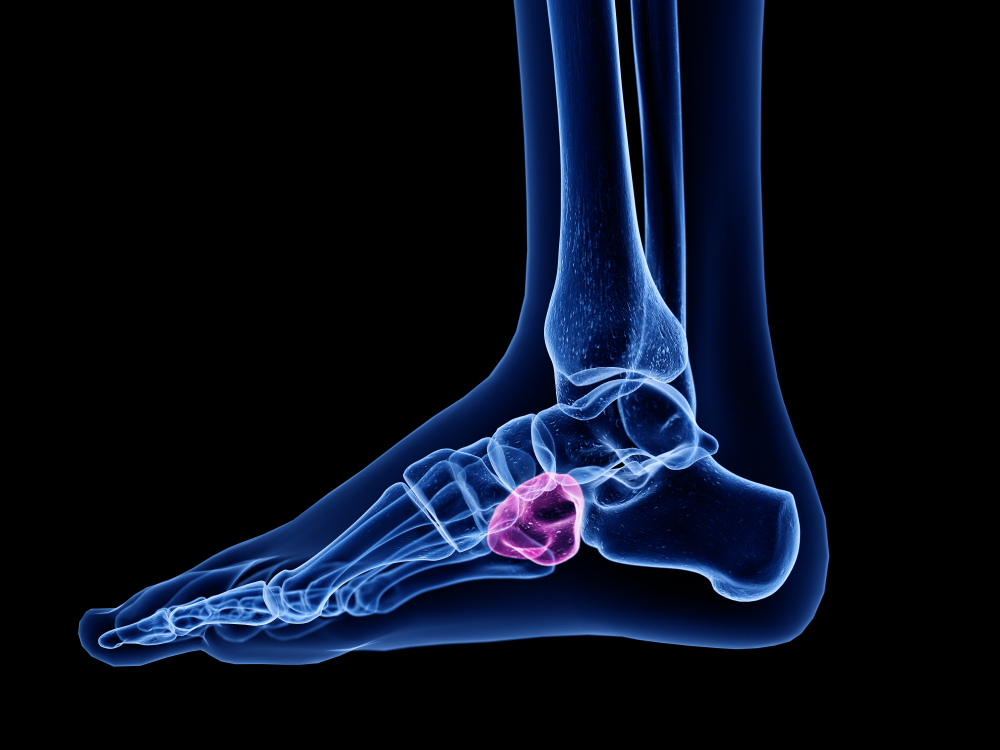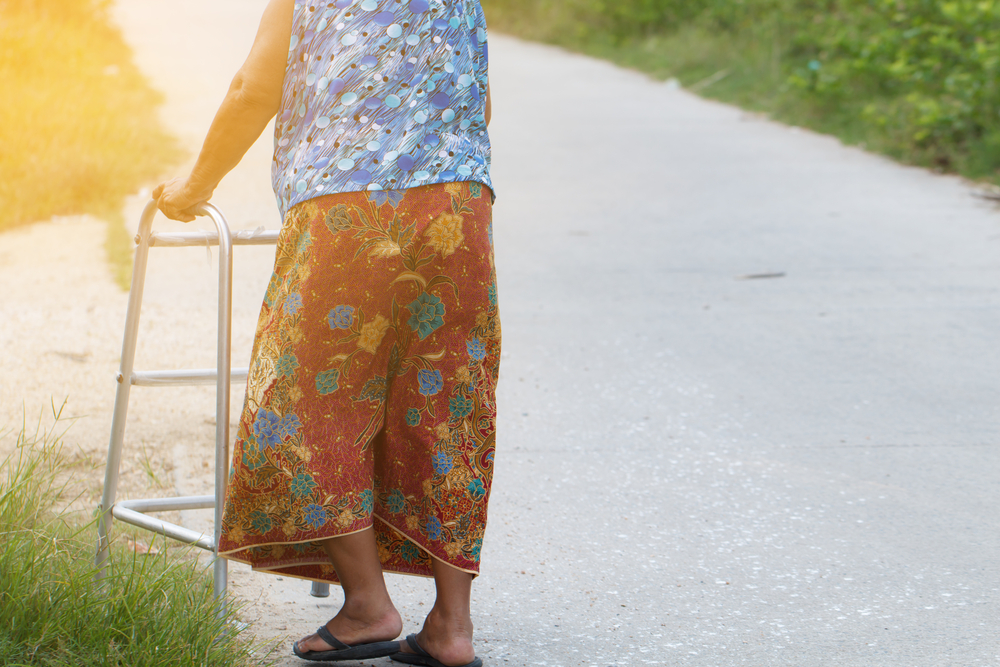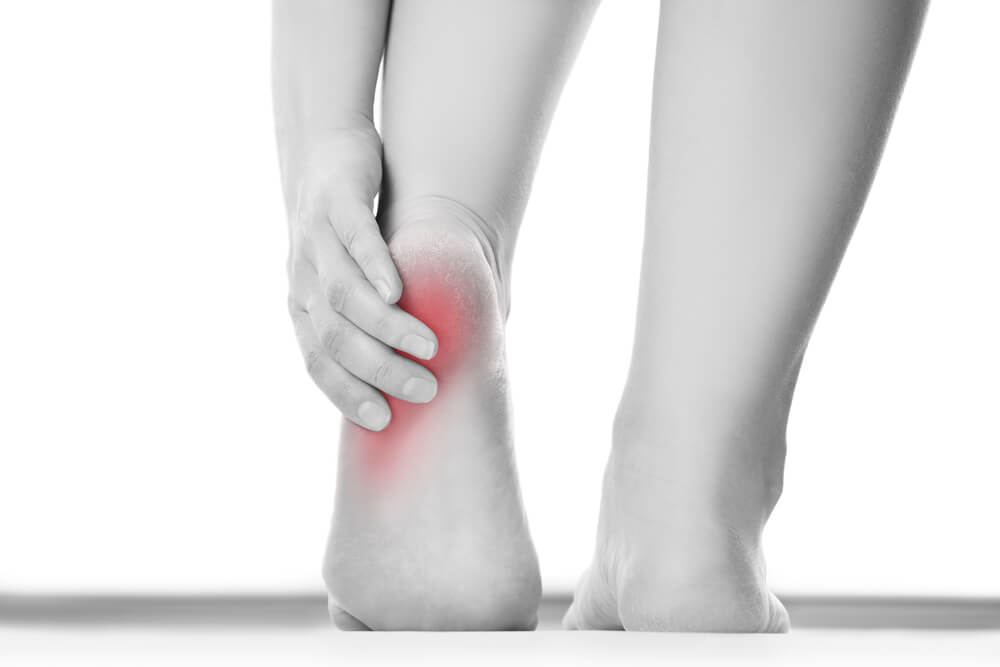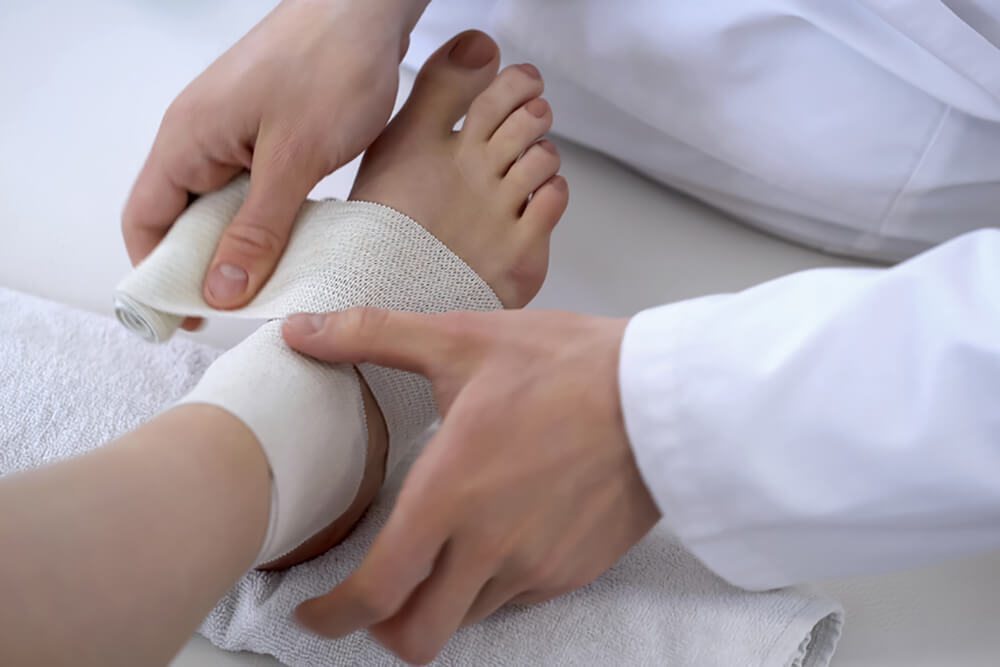Items filtered by date: January 2022
Cuboid Syndrome Causes
 Cuboid syndrome is a condition that is caused by a partial dislocation of the cuboid bone, located in the center of the foot. When this bone is knocked out of place during an injury, it can cause symptoms such as pain along the outside of the foot, swelling, sensitivity, difficulty walking, and a reduced range of motion. Cuboid syndrome is most frequently caused by repetitive overuse during athletic activities, like tennis, basketball, or dancing. When excessive stress is placed on the feet over and over, cuboid syndrome is more likely to occur. This condition is often associated with sprained ankles. Having altered foot biomechanics, a pronated gait,or a tendency to wear ill-fitting shoes can also increase your risk of injuring the cuboid bone. If you are experiencing the symptoms of cuboid syndrome, it is suggested that you seek the care of a podiatrist.
Cuboid syndrome is a condition that is caused by a partial dislocation of the cuboid bone, located in the center of the foot. When this bone is knocked out of place during an injury, it can cause symptoms such as pain along the outside of the foot, swelling, sensitivity, difficulty walking, and a reduced range of motion. Cuboid syndrome is most frequently caused by repetitive overuse during athletic activities, like tennis, basketball, or dancing. When excessive stress is placed on the feet over and over, cuboid syndrome is more likely to occur. This condition is often associated with sprained ankles. Having altered foot biomechanics, a pronated gait,or a tendency to wear ill-fitting shoes can also increase your risk of injuring the cuboid bone. If you are experiencing the symptoms of cuboid syndrome, it is suggested that you seek the care of a podiatrist.
Cuboid syndrome, also known as cuboid subluxation, occurs when the joints and ligaments near the cuboid bone in the foot become torn. If you have cuboid syndrome, consult with podiatrist Hartley Miltchin from Accent On Feet.Our clinicianwill assess your condition and provide you with quality foot and ankle treatment.
Cuboid syndrome is a common cause of lateral foot pain, which is pain on the outside of the foot. The condition may happen suddenly due to an ankle sprain, or it may develop slowly overtime from repetitive tension through the bone and surrounding structures.
Causes
The most common causes of cuboid syndrome include:
- Injury – The most common cause of this ailment is an ankle sprain.
- Repetitive Strain – Tension placed through the peroneus longus muscle from repetitive activities such as jumping and running may cause excessive traction on the bone causing it to sublux.
- Altered Foot Biomechanics – Most people suffering from cuboid subluxation have flat feet.
Symptoms
A common symptom of cuboid syndrome is pain along the outside of the foot which can be felt in the ankle and toes. This pain may create walking difficulties and may cause those with the condition to walk with a limp.
Diagnosis
Diagnosis of cuboid syndrome is often difficult, and it is often misdiagnosed. X-rays, MRIs and CT scans often fail to properly show the cuboid subluxation. Although there isn’t a specific test used to diagnose cuboid syndrome, your podiatrist will usually check if pain is felt while pressing firmly on the cuboid bone of your foot.
Treatment
Just as the range of causes varies widely, so do treatments. Some more common treatments are ice therapy, rest, exercise, taping, and orthotics.
If you have any questions, please feel free to contact our office located in Toronto, ON. We offer the newest diagnostic and treatment technologies for all your foot care needs.
Avoiding Falls as You Age
 One of the most common causes of serious injury in the elderly is falling. Among the reasons are chronic health conditions such as neuropathy (or numbness) in the feet, decreased bone density, being overweight, and reduced strength. In addition, certain medications and medical procedures can contribute to a general loss of balance. Falls at home can be prevented by making a few simple changes, such as removing throw rugs and loose carpeting, installing handrails, and wearing shoes with non-skid soles on slippery floors in your kitchen and bathrooms. Other measures include exercising to increase strength and improve balance, adequately lighting hallways, and removing clutter that is easy to trip over. Further, if your feet are frequently numb or it is painful to walk, falling may be a threat to your health. It may be a good idea to make an appointment with a podiatrist to evaluate your condition and discuss treatment options.
One of the most common causes of serious injury in the elderly is falling. Among the reasons are chronic health conditions such as neuropathy (or numbness) in the feet, decreased bone density, being overweight, and reduced strength. In addition, certain medications and medical procedures can contribute to a general loss of balance. Falls at home can be prevented by making a few simple changes, such as removing throw rugs and loose carpeting, installing handrails, and wearing shoes with non-skid soles on slippery floors in your kitchen and bathrooms. Other measures include exercising to increase strength and improve balance, adequately lighting hallways, and removing clutter that is easy to trip over. Further, if your feet are frequently numb or it is painful to walk, falling may be a threat to your health. It may be a good idea to make an appointment with a podiatrist to evaluate your condition and discuss treatment options.
Preventing falls among the elderly is very important. If you are older and have fallen or fear that you are prone to falling, consult withpodiatrist Hartley Miltchin from Accent On Feet.Our clinician will assess your condition and provide you with quality advice and care.
Every 11 seconds, an elderly American is being treated in an emergency room for a fall related injury. Falls are the leading cause of head and hip injuries for those 65 and older. Due to decreases in strength, balance, senses, and lack of awareness, elderly persons are very susceptible to falling. Thankfully, there are a number of things older persons can do to prevent falls.
How to Prevent Falls
Some effective methods that older persons can do to prevent falls include:
- Enrolling in strength and balance exercise program to increase balance and strength
- Periodically having your sight and hearing checked
- Discuss any medications you have with a podiatrist to see if it increases the risk of falling
- Clearing the house of falling hazards and installing devices like grab bars and railings
- Utilizing a walker or cane
- Wearing shoes that provide good support and cushioning
- Talking to family members about falling and increasing awareness
Falling can be a traumatic and embarrassing experience for elderly persons; this can make them less willing to leave the house, and less willing to talk to someone about their fears of falling. Doing such things, however, will increase the likelihood of tripping or losing one’s balance. Knowing the causes of falling and how to prevent them is the best way to mitigate the risk of serious injury.
If you have any questions, please feel free to contact our office located in Toronto, ON. We offer the newest diagnostic and treatment technologies for all your foot care needs.
What Can Make Your Heel Hurt?
 Heel pain is one of the most common reasons that people seek the care of a podiatrist. Because the heel is such a foundational part of the body, there are many potential reasons that your heel may hurt. Sometimes heel pain occurs as a natural consequence of aging. The fatty pad on the bottom of the heel, which provides cushioning and protection to the heels, slowly wears away with age, increasing the risk of heel pain. Various injuries, such as plantar fasciitis, Achilles’ tendonitis, fractures, sprains, and tarsal tunnel syndrome, can also make the heel hurt. Systemic conditions, including arthritis and peripheral neuropathy, may be to blame for your heel pain. Lifestyle factors, such as wearing ill-fitting shoes or standing or exercising excessively can contribute to heel pain as well. If you are suffering from heel pain, it is suggested that you see a podiatrist for treatment.
Heel pain is one of the most common reasons that people seek the care of a podiatrist. Because the heel is such a foundational part of the body, there are many potential reasons that your heel may hurt. Sometimes heel pain occurs as a natural consequence of aging. The fatty pad on the bottom of the heel, which provides cushioning and protection to the heels, slowly wears away with age, increasing the risk of heel pain. Various injuries, such as plantar fasciitis, Achilles’ tendonitis, fractures, sprains, and tarsal tunnel syndrome, can also make the heel hurt. Systemic conditions, including arthritis and peripheral neuropathy, may be to blame for your heel pain. Lifestyle factors, such as wearing ill-fitting shoes or standing or exercising excessively can contribute to heel pain as well. If you are suffering from heel pain, it is suggested that you see a podiatrist for treatment.
Many people suffer from bouts of heel pain. For more information, contact podiatrist Hartley Miltchin from Accent On Feet.Our clinician can provide the care you need to keep you pain-free and on your feet.
Causes of Heel Pain
Heel pain is often associated with plantar fasciitis. The plantar fascia is a band of tissues that extends along the bottom of the foot. A rip or tear in this ligament can cause inflammation of the tissue.
Achilles tendonitis is another cause of heel pain. Inflammation of the Achilles tendon will cause pain from fractures and muscle tearing. Lack of flexibility is also another symptom.
Heel spurs are another cause of pain. When the tissues of the plantar fascia undergo a great deal of stress, it can lead to ligament separation from the heel bone, causing heel spurs.
Why Might Heel Pain Occur?
- Wearing ill-fitting shoes
- Wearing non-supportive shoes
- Weight change
- Excessive running
Treatments
Heel pain should be treated as soon as possible for immediate results. Keeping your feet in a stress-free environment will help. If you suffer from Achilles tendonitis or plantar fasciitis, applying ice will reduce the swelling. Stretching before an exercise like running will help the muscles. Using all these tips will help make heel pain a condition of the past.
If you have any questions, please feel free to contact our office located in Toronto, ON. We offer the newest diagnostic and treatment technologies for all your foot care needs.
Should I Walk On a Sprained Ankle?
 Ankle sprains are fairly common among active adults. A sprained ankle is usually caused by the overstretching or twisting of a ligament around a joint. With a mild sprain, you may not even realize it for the first few hours. Later on, some swelling, and in some cases discoloration, may become apparent. A sprain is also likely if your range of motion is reduced. At that point, basic first aid recommendations include ice, compression and elevation. The question is, how serious is it, and can I still walk on it? Generally, it’s not a good idea to put weight on a sprained ankle. Using crutches or a walker may help you get around, until you can seek medical assistance. It’s a good idea to call a podiatrist as soon as possible for a more extensive examination and diagnosis.
Ankle sprains are fairly common among active adults. A sprained ankle is usually caused by the overstretching or twisting of a ligament around a joint. With a mild sprain, you may not even realize it for the first few hours. Later on, some swelling, and in some cases discoloration, may become apparent. A sprain is also likely if your range of motion is reduced. At that point, basic first aid recommendations include ice, compression and elevation. The question is, how serious is it, and can I still walk on it? Generally, it’s not a good idea to put weight on a sprained ankle. Using crutches or a walker may help you get around, until you can seek medical assistance. It’s a good idea to call a podiatrist as soon as possible for a more extensive examination and diagnosis.
Although ankle sprains are common, they aren’t always minor injuries. If you need your ankle injury looked at, contact podiatrist Hartley Miltchin from Accent On Feet.Our clinician can provide the care you need to keep you pain-free and on your feet.
How Does an Ankle Sprain Occur?
Ankle sprains are the result of a tear in the ligaments within the ankle. These injuries may happen when you make a rapid shifting movement while your foot is planted. A less common way to sprain your ankle is when your ankle rolls inward while your foot turns outward.
What Are the Symptoms?
- Pain at the sight of the tear
- Bruising/Swelling
- Ankle area is tender to touch
- In severe cases, may hear/feel something tear
- Skin discoloration
Preventing a Sprain
- Wearing appropriate shoes for the occasion
- Stretching before exercises and sports
- Knowing your limits
Treatment of a Sprain
In many cases, the RICE method (Rest, Ice, Compression, and Elevate) is used to treat ankle sprains. However, you should see a podiatrist to see which treatment option would work best with your injury. In severe cases, surgery may be required.
It is important to ask your podiatrist about rehab options after you receive treatment for your injury. Stretching, strength training, and balance exercises may help the ankle heal while also preventing further injury.
If you have any questions, please feel free to contact our office located in Toronto, ON. We offer the newest diagnostic and treatment technologies for all your foot care needs.
